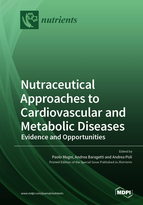Nutraceutical Approaches to Cardiovascular and Metabolic Diseases: Evidence and Opportunities
A special issue of Nutrients (ISSN 2072-6643). This special issue belongs to the section "Clinical Nutrition".
Deadline for manuscript submissions: closed (20 July 2021) | Viewed by 60625
Special Issue Editors
Interests: metabolic diseases; obesity and adipokines; insulin resistance and diabetes; cardiovascular disease; atherosclerosis; nutraceuticals; nutrition; metabolic biomarkers
Special Issues, Collections and Topics in MDPI journals
Interests: internal medicine; cardiovascular pharmacology; cardiovascular genomic; translational immunometabolism
Special Issues, Collections and Topics in MDPI journals
Special Issue Information
Dear Colleagues,
Cardiovascular and metabolic diseases are still the major cause of mortality, morbidity and disability worldwide. Their prevention and treatment should take advantage of lifestyle changes and, when appropriate, of pharmacological approaches. These may be integrated by the nutraceutical option, which, according to an increasing number of research papers, appears to be an additional and effective asset in this biomedical field. However, several issues still remain open regarding the efficacy and the safety of nutraceutical products for managing cardiometabolic diseases. Among them, the quality of evidence required to inform guidelines, the quality of nutraceutical products and the related regulatory aspects, and the actual role of probiotics in this area.
These and other critical issues, along with the most robust evidence from clinical trials, will be addressed in this Special Issue of Nutrients, which aims to implement a qualified and open evidence-based discussion on the use of nutraceutical products for cardiometabolic health, thus providing an up-to-date set of information useful for basic, translational and clinical readers.
Prof. Dr. Paolo MagniDr. Andrea Baragetti
Dr. Andrea Poli
Guest Editors
Manuscript Submission Information
Manuscripts should be submitted online at www.mdpi.com by registering and logging in to this website. Once you are registered, click here to go to the submission form. Manuscripts can be submitted until the deadline. All submissions that pass pre-check are peer-reviewed. Accepted papers will be published continuously in the journal (as soon as accepted) and will be listed together on the special issue website. Research articles, review articles as well as short communications are invited. For planned papers, a title and short abstract (about 100 words) can be sent to the Editorial Office for announcement on this website.
Submitted manuscripts should not have been published previously, nor be under consideration for publication elsewhere (except conference proceedings papers). All manuscripts are thoroughly refereed through a single-blind peer-review process. A guide for authors and other relevant information for submission of manuscripts is available on the Instructions for Authors page. Nutrients is an international peer-reviewed open access semimonthly journal published by MDPI.
Please visit the Instructions for Authors page before submitting a manuscript. The Article Processing Charge (APC) for publication in this open access journal is 2900 CHF (Swiss Francs). Submitted papers should be well formatted and use good English. Authors may use MDPI's English editing service prior to publication or during author revisions.
Keywords
- nutraceutics
- cardiovascular diseases
- metabolic diseases
- dyslipidemia
- vascular health
- chronic inflammation
- integrative medicine









